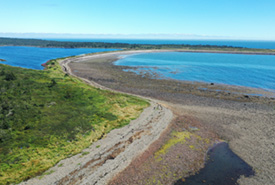Conservation partners will be active on Brier Island this year

Brier Island, Nova Scotia (Photo by BrainWorks Marketing)
Beginning in 2023, residents and visitors to Brier Island will see some renewed activity by conservation partners.
The Nature Conservancy of Canada (NCC) is planning major upgrades to the Brier Island Coastal Trail. Anyone who has been on the trail in wetter weather is aware of the long muddy puddles that have to be crossed. As well, the water crossings installed in 2010 with the help of local students will be improved. In some cases, stone swales will replace the wooden structures. The overall work will make the trail more resilient to ongoing use and weathering. Current signage will also be refreshed. It’s anticipated the work will begin this summer and extend into 2024. There will be opportunities for volunteers to help, including students from the Islands Consolidated School.
In 2022, NCC acquired a new conservation property, an 11-hectare parcel along Lighthouse Road. The property is the location of the “Reference Bog” — a pristine wetland and benchmark for the ongoing Big Meadow Bog restoration. Conservation partners, including Environment and Climate Change Canada, NS Department of Natural Resources and Renewables, Mersey Tobeatic Research Institute, Acadia University and the Southwest Biosphere Region Association (Nick Hill), will be active with ongoing work there this year.
The Big Meadow Bog water table was returned to its original level in 2017 by East Coast Aquatics. This was a watershed event and one that all the biologists responsible for endangered species in Canada and Nova Scotia had been pushing for years. This winter, Mike Parker and Andy Sharpe of East Coast Aquatics went back into the bog to check on how the 150 ditch blocks — peat tamped into the ditches and berms — throughout the Big Meadow Bog were holding up after five years. Very well, it turns out, and only one or two need a bit of excavator work.
The restoration project to save the eastern mountain avens caught the attention of many in the conservation world and it’s a story learned by visitors to Brier as they walk the boardwalk. But if the damage to the project continued on for 60 years, its recovery and the rebounding of the avens will take time. NCC is restarting the avens from seeds in patches on the sides of the meadow, which are now properly wetted. A group made up of the Brier Island Trails Committee and many others are looking into ways of discouraging the thousands of herring gulls that nest in and foul the bog with their waste. Those activities started in April and will continue through to June.
These are just some of the efforts being undertaken here and, together, they show the commitment that NCC has to conserving the wetlands of Brier Island and what may be the rarest plant in Canada. Many thanks to all those involved: those who fund the boardwalk, fix the trails and broken boards, go to meetings, teach the children, run the ferries, talk up Brier to mainlanders, and enjoy and respect this natural world.
Submitted by Doug van Hemessen (Nature Conservancy of Canada) and Nick Hill (Fernhill Institute for Plant Conservation). Previously published in Passages – The Long Island, Brier Island and Digby Neck News.





